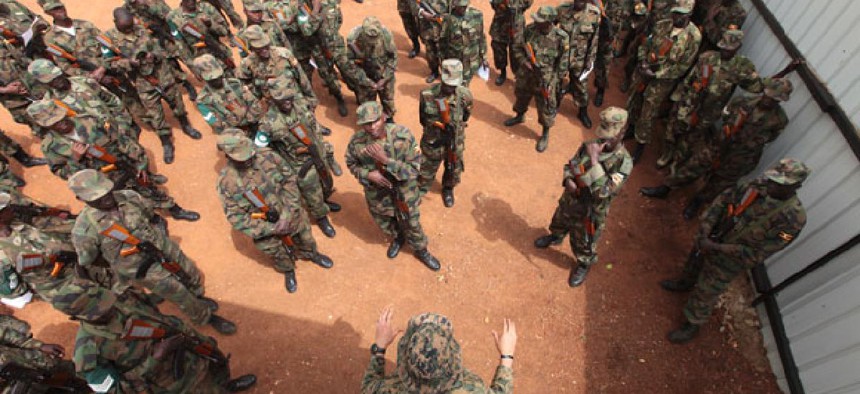
A U.S. Marine team trains Ugandan forces to face groups like al-Shabaab. Defense Department
Outsourcing the Fight Against Terrorism
The United States is using local soldiers to fight al-Qaida allies in East Africa.
MANDA BAY NAVAL BASE, Kenya—The C-12 twin-engine turboprop drops through a break in the clouds, and Kenya’s tropical Lamu Archipelago, surrounded by coral-green waters, emerges like a lost continent. Cuticles of virgin white beach line a jungle that stretches back into the country’s interior. Banking, the pilot spots a short airstrip cut out of the foliage. The station below is one of the remotest outposts in an expanding U.S. network of staging bases in Africa. The clouds close when the rainy season arrives in mid-March, and Manda Bay can go for weeks, even months, without so much as a mail drop. The C-12 touches down on an unlit runway and stops.
Out comes Maj. Gen. Ralph Baker, commander of the Combined Joint Task Force–Horn of Africa. The organization was once a sleepy command focused on digging wells and liaising with local militaries. Now CJTF-HOA is remaking itself into a counterterrorism force bent on defeating transnational extremist groups in a region the size of America’s Eastern Seaboard. Baker is here on a hot January day to inspect a forward operating site crucial in his campaign to help destroy the terrorist group al-Shabaab in Somalia. American policymakers are already talking about how these battles offer a model for the fight against other Qaida affiliates in Africa.
Waiting on the tarmac is Lt. Carl Chase, who leads a detachment of Navy Seabee engineers who have been working round-the-clock shifts for months to finish a runway extension before the rainy season arrives. Once completed, it will allow larger aircraft like C-130s to land and supply Americans or African Union troops. Baker climbs into Chase’s SUV and rides down the long asphalt road lined with baboons the size of teenagers. (A viral video shows two Marines playfully trying to put a T-shirt on one such neighbor. Both ended up in the hospital. “Other than car wrecks, close encounters with the wildlife is the top cause of injury to my people in Africa,” the general says.)
Entering the base, Baker’s convoy passes black-clad Kenyan antiterrorism commandos mustering in the sun. Farther on, it glides by a platoon of Kenyan Special Boat Forces trained by U.S. special operations forces to deploy on inflatable, rigid-hull boats. They are learning repackaged lessons from Iraq and Afghanistan, including countering IEDs, gathering intelligence, and marksmanship. “We’ve seen that enhanced training pay big dividends,” a senior U.S. officer says.
In fact, many African Union troops battling Shabaab militants in Somalia have been trained, equipped, and sustained by an international coalition led by the United States and coordinated through the State Department and CJTF-HOA. Last summer, for instance, Kenyan rangers trained by American Green Berets ran joint exercises with the Kenyan boat forces here. In September, armed with operational doctrine right out of the U.S. special forces handbook, they made an amphibious landing at the Somali port city of Kismayo and quickly routed Shabaab insurgents from their last urban stronghold—denying the terrorists a key port of resupply from the Arabian Peninsula.
In Iraq and Afghanistan, where U.S. officers honed the tactics they teach here (Baker did several combat tours in Iraq), Americans led the fight against terrorists and insurgents. But in Washington, policymakers are now focused on shaving budgets and bringing home troops. And, Baker says, “there are not a lot of governments who want a big U.S. military footprint in their countries.” So Pentagon strategists need a cheaper way to fight militant Islamists—many of them operating, unmolested, in Africa—who would unseat our allies or attack our homeland.
In Africa, they think they’ve found it. The call it the “train, assist, and enable” model, and they’re testing it on a large scale. The officials teach the counterterrorism lessons learned in the last decade to foreign militaries, empower them with U.S. capabilities such as intelligence-gathering, and then let the African militaries police their own backyards. “That doesn’t mean the United States will never again intervene militarily in another country with boots on the ground,” Baker says. “But the more proactive we are in engaging with foreign partners, and the more predictive we are in identifying common threats, the less likely a future U.S. intervention will be necessary.” U.S. officials here call this “African solutions to African problems.” Which is convenient, because borderless Islamist militants are also American problems. This model represents a new style of American war-fighting for an era of austerity. Call it leading from the shadows.







